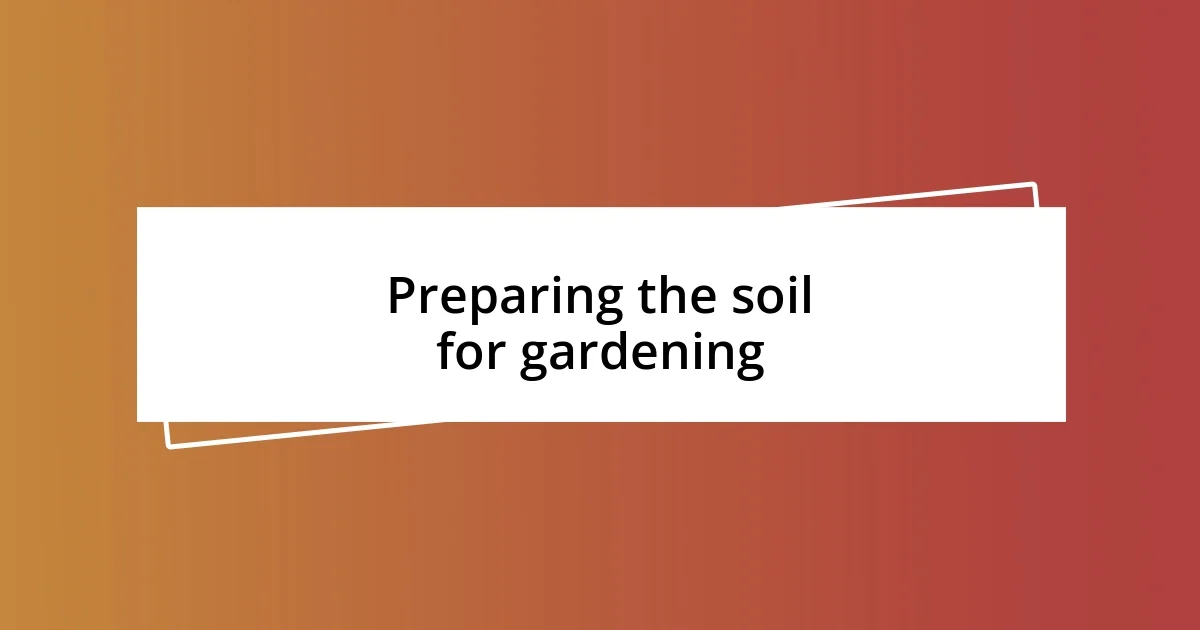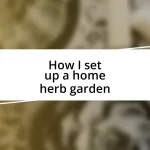Key takeaways:
- Effective backyard planning involves considering movement flow, sunlight, and shade for a harmonious garden layout.
- Choosing the right plants is crucial, focusing on climate suitability, light requirements, personal favorites, maintenance level, and seasonal interest.
- Regular garden maintenance, including pruning and weeding, enhances plant health and fosters a deeper connection with the garden.

Planning your backyard layout
When I began planning my backyard layout, I found it helpful to visualize the space from different angles. I remember sitting on my deck with a cup of coffee, sketching ideas while soaking in the sunlight—and that moment really sparked my creativity. Have you ever tried placing yourself in various spots in your yard to see how it feels? It can change everything!
One valuable insight I gained was to consider the natural flow of movement within the space. I opted for winding pathways that led to cozy seating areas, inviting family and friends to wander and relax. Think about your own backyard: do your pathways encourage exploration, or do they feel more like an obstacle course?
Another aspect I meticulously planned was the balance between sunlight and shade. I planted a couple of trees in strategic spots, knowing how soothing it can be to have a shaded nook on a hot summer day. How do you envision the harmony of light and dark in your garden? That blend can create a dynamic environment that not only pleases the eye but also nurtures various plants.

Choosing the right plants
When it came to choosing the right plants for my garden, I felt a mix of excitement and uncertainty. I remember strolling through a local nursery, overwhelmed by the colorful blooms and fragrant herbs, feeling like a kid in a candy store. I’ve learned that the selections you make can truly influence not just the aesthetics but also the overall vibe of your garden.
To narrow down my choices, I focused on these key aspects:
- Climate Suitability: I checked the USDA Plant Hardiness Zone for my area to understand what thrives best.
- Light Requirements: I observed how the sunlight patterns shifted throughout the day, and I tried selecting plants that would thrive in both shade and full sun.
- Personal Favorites: I made sure to include plants that brought me joy, like vibrant zinnias and fragrant lavender, because emotional connection plays a significant role in creating a peaceful retreat.
- Maintenance Level: I considered how much time I could dedicate to upkeep; I personally prefer low-maintenance varieties that still add beauty.
- Seasonal Interest: I aimed for a mix of perennials and annuals to ensure something would be blooming every season, which keeps the garden lively year-round.
By carefully considering these elements, I felt more confident in my plant choices and excited for the transformation ahead.

Preparing the soil for gardening
When I decided to prepare the soil for my garden, I quickly realized that it was like laying the foundation for a house. I started by evaluating the existing soil, which was mostly clay and quite compacted. I can still recall the effort I put into turning that soil over; it felt therapeutic as I dug deep, feeling the earth’s coolness beneath my hands. Have you ever felt that satisfying connection to the ground while gardening? It’s like the soil welcomes your touch.
Next, I added organic matter to improve the soil texture and boost nutrient content. I remember carting in bags of compost and well-rotted manure—it felt like I was giving my garden a hearty meal. The transformation was remarkable! I learned that mixing in compost not only enriched the soil but also improved its drainage. If you’re planning a garden, think about incorporating organic materials. They really do create a vibrant ecosystem for your plants.
Lastly, I ensured that the pH level of my soil was just right for the plants I chose. Using a simple soil test kit, I discovered my soil was slightly acidic, which worked well for most of my selections but needed some tweaking for a few others. Balancing the pH was a bit of a science project for me, but it turned out to be a rewarding challenge. What’s your experience with testing soil? It’s a fascinating way to understand your garden better!
| Soil Type | Characteristics |
|---|---|
| Clay | Dense, holds water, but drains poorly |
| Sandy | Light, drains quickly, less nutrients |
| Silt | Rich in nutrients, retains moisture well |
| Loam | Ideal for gardening, balanced texture and nutrients |

Designing garden paths and borders
Designing paths and borders in my garden turned out to be one of the most rewarding aspects of my backyard transformation. I remember standing in the middle of my yard, sketching ideas in my notebook, and feeling a sense of purpose. The paths would guide visitors through the floral tapestry I was creating, and choosing the right materials made all the difference. I opted for rustic stones, which complemented the natural surroundings and added a timeless charm. Have you ever walked on a beautiful path and felt instantly at ease? It’s amazing how much the ground beneath your feet can influence your experience.
In laying out the borders, I was careful to define spaces while allowing for a sense of flow. I recall how I used a combination of low-maintenance edging plants, like lavender and creeping thyme, to create visual separation without being overly rigid. I wanted both structure and softness, a balance that I believe invites people to linger. When I see those borders now, I feel a sense of pride—like the garden is giving a warm hug to everyone who walks by.
One of my favorite features is the winding path that leads to a cozy seating area. I can still picture how it wound through tufts of blooming flowers and edible herbs, leading me to a tranquil spot where I could unwind. To keep the path functional yet appealing, I incorporated stepping stones interspersed with gravel. This approach not only enhances the visual appeal but also provides a practical solution for navigating my garden after rain. Have you considered creating a path that tells its own story? Each step can unveil new beauty, encouraging exploration and discovery.

Installing irrigation systems
Installing an irrigation system was a game-changer for my garden. In the heat of summer, I found myself running back and forth with watering cans, which became a workout rather than a gardening delight. So, I took the plunge and installed a drip irrigation system. This method delivers water directly to the roots of my plants, saving time and ensuring they get the moisture they need without waste. Have you ever felt the satisfaction of knowing your plants are well taken care of, even while you relax with a cool drink?
I learned that planning is key when setting up an irrigation system. Initially, I sketched a layout, mapping out where my beds were and how many plants I had. I can vividly remember being excited about the potential of not just watering my garden efficiently but also conserving water. After all, it’s a crucial resource, isn’t it? Watching the water seep into the soil, nourishing my plants, was a monumental moment for me, adding a new layer of connection to my gardening journey.
I also wanted to incorporate timers, making it even more convenient. On days I was busy, it was reassuring to know that my garden was still thriving while I was away. The first time I set the timer and watched it work, I felt surreal. It was like having a little assistant tending to my plants while I focused on other things. Have you thought about how technology can make gardening easier? It truly opened my eyes to the possibilities in sustainable gardening.

Maintaining your garden regularly
Maintaining your garden regularly has become a ritual for me that brings immense joy and fulfillment. I remember the first time I spent a quiet Saturday morning pruning my plants, the snip of the shears echoing like a soothing soundtrack. It’s surprising how such a simple act can strengthen my bond with the garden, almost like a conversation where I’m checking in on the health of each bloom. What chores do you look forward to in your gardening routine?
Weeding is another vital task that I’ve come to appreciate. I had this moment the other day when I plucked a stubborn dandelion from my flowerbed, and I couldn’t help but think, “Every weed pulled is room for beauty to flourish.” It was invigorating to see the transformation that a little dedication and diligence could bring, clearing space for my beloved petunias and daisies to shine through. Maintaining a regular weeding schedule has become essential for me, as it not only keeps my garden looking pristine but also allows my flowers to thrive, which adds to my own sense of accomplishment.
I initially struggled with the balance of watering. I often found myself second-guessing, unsure if I was giving them too much or too little. Now, I’ve established a rhythm, checking the soil moisture every few days. I can still vividly recall the satisfaction I felt when I discovered that simple act of touching the soil could tell me everything. It’s immensely rewarding to know my efforts directly contribute to my plants’ health, creating a vibrant habitat in my backyard. Have you noticed how nurturing your garden can nurture your soul at the same time?














